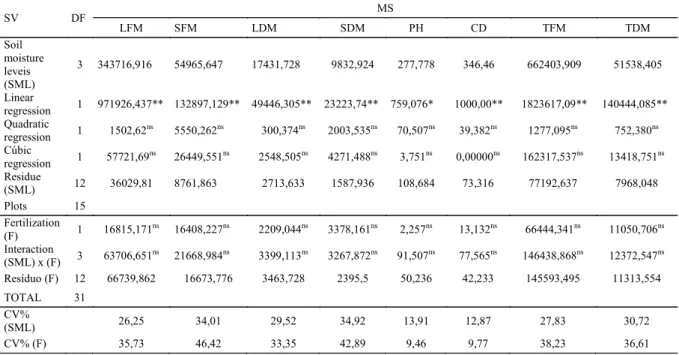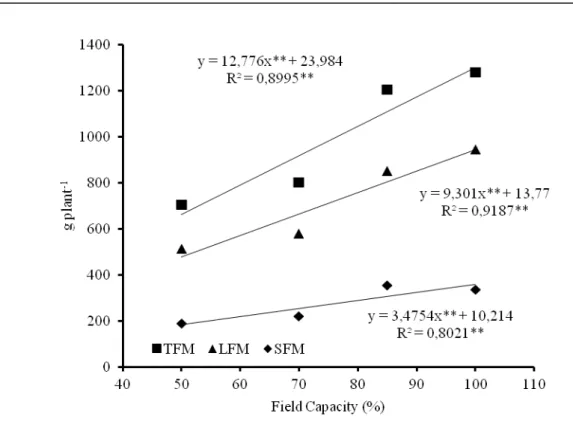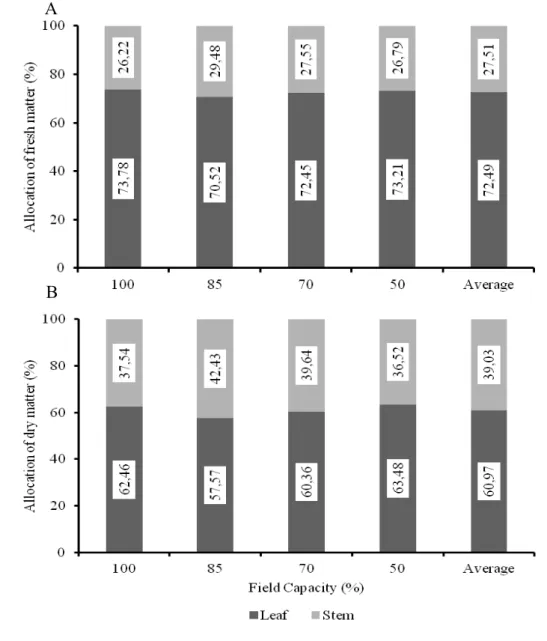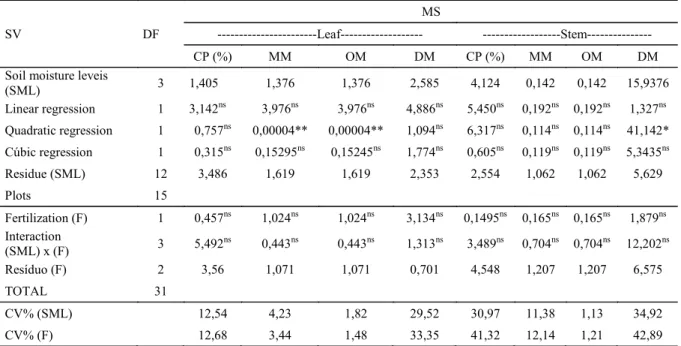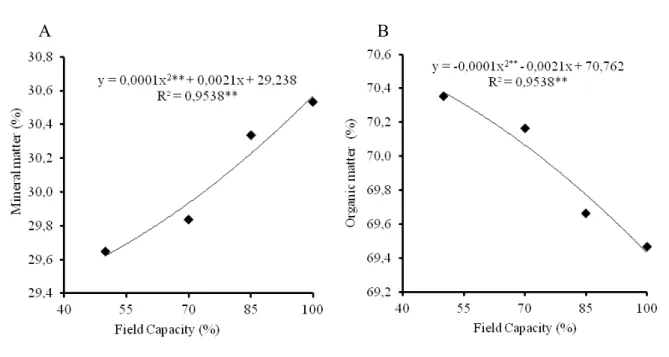Rev. Caatinga
YIELD AND FORAGE QUALITY OF SALTBUSH IRRIGATED WITH REJECT
BRINE FROM DESALINATION PLANT BY REVERSE OSMOSIS
1EDYMARA SINTHIA ROCHA DE MOURA*2; CHRISTIANO REBOUÇAS COSME3; NILDO DA SILVA DIAS3;
JEANE CRUZ PORTELA3; ANA CLAUDIA MEDEIROS SOUZA3
ABSTRACT- Rural communities located in the Brazilian Northeast, especially in the semiarid zone, live with water shortages resulting from erratic rainfall. This work proposes the cultivation of saltbush (Atriplex
nummularia) in the Rural Settlement Project of Boa Fé, Mossoró/RN as alternative to the disposal of reject
brine from desalination plant on yield of forage. The statistical design was a split-plot design, being four treatments at the plots, related to irrigation with reject brine water, at different levels of soil moisture by moisture from Field Capacity (FC) (100, 85, 70 and 50% of FC) and in subplots and two levels of organic manure (without fertilized and fertilized) with four replications. The variables of yield and forage quality of saltbush were analyzed. It was observed that saltbush has a great production capacity in terms of fresh matter and drought for saltbush under a level of 85% soil moisture in relation to the field capacity of soil, presenting minimal loss of yield; however, this proved to be productive even with the dry soil. The total yield was satisfactory, showing its viability for forage production.
Keywords: Atriplex nummularia. Water reuse. Salinity.
PRODUÇÃO E QUALIDADE FORRAGEIRA DA ERVA SAL IRRIGADA COM REJEITO DA DESSALINIZAÇÃO POR OSMOSE REVERSA
RESUMO- As comunidades rurais situadas no Nordeste brasileiro, em especial na região semiárida, convivem com a escassez de água resultante da irregularidade das chuvas nesta região. O presente trabalho propôs cultivar a erva sal (Atriplex nummularia) no Projeto de assentamento Rural Boa Fé, Mossoró/RN como alternativa à deposição do rejeito salino para a produção de forragem. O delineamento estatístico foi parcelas subdivididas, sendo quatro tratamentos nas parcelas, referentes a irrigação com rejeito salino em diferentes níveis de umidade do solo tendo como base a umidade na Capacidade de Campo (CC) (100, 85, 70 e 50% da CC) e nas subparcelas, dois níveis de adubação orgânica (não adubado e adubado), com quatro repetições. Foram analisadas variáveis de produção e qualidade da forragem da erva sal. Observou-se que, a erva sal possui boa capacidade de produção de matéria fresca e seca sob um nível de 85% de umidade do solo em relação à sua capacidade de campo, apresentando mínimas perdas de rendimento, porém, mostrou-se produtiva mesmo com o solo mais seco. A produtividade total foi satisfatória mostrando sua viabilidade para a produção de forragem.
Palavras-chave: Atriplex nummularia. Reuso de água. Salinidade.
______________________ *Corresponding Author
1Received for publication in 02/04/2014; accepted in 11/12/2015.
Extracted from the first author's Master's dissertation, funded by CNPq.
2Universidade do Estado do Rio Grande do Norte, Mossoró, RN, Brazil; mara_srm@hotmail.com.
3Department of Environmental Sciences and Technological, Universidade Federal Rural do Semi-Árido, Mossoró, RN, Brazil;
Rev. Caatinga
INTRODUCTION
In the Brazilian Northeast, especially in the semiarid region, irregular rainfalls cause a scarcity of shallow water deposits, resulting in a lack of water. In most rural communities of this region, the existence of this phenomenon is remarkable. However, it results in problems regarding the supply of drinking water. In view of this problem and the great potential groundwater resources, the drilling of wells to pump these waters has become a viable alternative commonly used for the irrigation of various horticulture areas through shallow wells with a low construction cost but with relatively high salt concentrations (SOUZA et al., 2009; DIAS et al., 2011; SOARES et al., 2015).
The drilling of wells has been used as a source of water for many rural communities of this region. However, even with groundwater being identified as a viable alternative to ensure access to water by rural communities in the Northeast, such sources of water present in most cases use restrictions for human consumption because of salinity problems (MEDEIROS et al., 2014; TERCEIRO NETO et al., 2014).
To minimize this problem, the Federal Government established the Freshwater Program. Its main objective is to solve the lack of water supply in these communities by installing and maintaining reject brine from desalination plant in rural communities to treat water from wells (SOARES et al., 2006). In Mossoró, this program has benefited about 50 communities.
Reverse osmosis is a technology widely used for the treatment of brackish water (PORTO et al., 2006), with successful experiences in most locations where desalting water treatment units are implemented. The use of reverse osmosis desalination has progressed remarkably, and the market and its applications are being considerably expanded. However, its economic aspect limits its expansion.
The deposition of the waste generated by treatment plants creates environmental concerns because of its high soil or water polluting capacity, if the process is not done correctly. In view of this, alternatives to this waste reuse are being studied. The use of evaporation tanks, tilapia and shrimp breeding and cultivation of halophytes are current alternatives more convenient to the destiny of this waste.
Regarding the cultivation of halophytes,
Atriplex nummularia, also known as saltbush, has
excelled in Brazil, being the object of several studies. Because it is from arid regions, Atriplex is especially important because it is able to produce and maintain an abundant biomass even in high aridity and salinity environments (PORTO et al., 2006). It is important to the phytoremediation process of soils affected by salts because it is convenient to the requirements of this process; it produces an abundant biomass in soils with a high salt content and tolerates drought, a common factor in arid and semi-arid areas (SOUZA et al., 2012).
From this perspective, this study aimed to use reject brine from desalination plant located at the settlement Project Boa Fé (Mossoró, RN) for the irrigation of saltbush (Atriplex nummularia) in order to evaluate its yield potential and forage quality.
MATERIAL AND METHODS
The experiment was conducted from September to December 2012 in the Settlement Project Boa Fé, located along the BR 304 highway, rural zone of the municipality of Mossoró, RN (geographical coordinates: 5º03'07.32" S and 37º20'22.42" W). The experimental area was 180 m². It is located near a brackish water treatment station, facilitating handling the saline waste to be used in research.
An irrigation system localized by gravity was chosen mainly because it does not require electrical power to operate. Microtube emitters of 1.5 mm in diameter and 1.5 m in length were used, resulting in an average flow rate of 5.0 L h-1. In order to standardize irrigation, both the irrigation hoses and the height of the water emission by the microtube were leveled in the entire experiment area. The Christiansen Uniformity Coefficient (CUC) was calculated, obtaining 93% uniformity.
A reservoir for waste storage to be used for irrigation, with a capacity of 1,000 L, was placed on a wooden structure at a 2.0 m height. It was installed in the center of the experimental area for a better distribution of irrigation water to plants. The chemical composition of the reject brine from desalination plant by reverse osmosis used in irrigation is shown in Table 1.
Table 1. Physical and chemical characteristics of the reject brine from desalination plant used in the irrigation of
1SAR = Na+/[(Ca2+ + Mg2+)/2]1/2
pH EC K+ Na+ Ca2+ Mg2+ Cl- CO
32- HCO3- SAR1 Hardness ∑Cations ∑Anions
(water) dS m-1 --- mmolc L-1 --- - mg L-1 --- mmolc L-1 ---
Rev. Caatinga
The experimental design was a split plot design with four treatments related to soil moisture levels based on moisture of Field Capacity (FC) in plots and subplots and two levels of organic fertilization, with four replications and two plants per subplot, totaling 64 plants. Based on the soil water retention curve, the voltage at field capacity was set to 6 kPa (60 cm.ca) and the moisture in FC corresponded to 0.1456 cm3 cm-3. This voltage to determine FC in the experiment was adopted because the soil is granulometrically classified as sandy loam based on the function of the level of sand, silt and clay, which provides it with relevant drain power. In addition, several authors have postulated that the field capacity for tropical soils corresponds to voltages ranging from 6 to 10 kPa (MELLO et al., 2002; ANDRADE; STONE, 2011).
The effects of irrigation with reject brine water, at different levels of soil moisture were tested. The treatment of the plots was thus determined as T1 = 100% of FC (0.1456 cm3 cm-3),
T2 = 85% of FC (0.1238 cm3 cm-3), T3 = 70% of FC
(0.1019 cm3 cm-3) and T
4 = 50% of FC (0.0728 cm3
cm-3). In the subplots, the treatments were without fertilization (F0) and with an organic fertilizer (F1).
The organic feedstock was goat manure in the amount of 1.5 L per plant. The fertilizer was manually applied in a single dose on 15 cm-deep holes lateral to the plant.
Irrigation was performed daily. Based on the average readings from strains of water in the soil using tensiometers installed in each experimental plot, the current soil moisture was obtained in each treatment using the soil water retention curve, allowing calculation of the volume of irrigation necessary to maintain the soil moisture levels proposed by the treatments.
At the beginning of the experiment, all plants that were six months were cut, maintaining the height and the crown diameter at 40 cm with the aid of a cylindrical-shaped mold made of PVC with these dimensions in order to standardize the size of the plants, thus facilitating the measurement of production at the end of the production cycle, the moment when the cutting was carried out (harvest) after three months of cultivation.
Before the saltbush cutting, measurements of the crown diameter (CD) and plant height (PH) of all plants were performed. Then, there was a cutting of all separated material into leaves and stems to determine leaf fresh matter (LFM), stem fresh matter (SFM), and total fresh matter (TFM) by the sum of LFM and SFM. Leaf dry matter (LDM) and stem dry matter (SDM) were obtained after drying the material in an oven with forced air circulation at 65° C until constant weight. The total dry matter (TDM) was obtained by the sum of LDM and SDM.
To evaluate the quality of the forage produced by saltbush, the percentage of dry matter (DM) and levels of organic matter (OM), mineral matter (MM)
and crude protein (CP) were determined according to the methodology described by Silva and Queiroz (2002).
The data were submitted to ANOVA and regression for a quantitative treatment of plots and to an average test of subplots using Assistat® software
(SILVA; AZEVEDO, 2009).
RESULTS AND DISCUSSION
All growth and production variables of saltbush analyzed suffered significant linear effects influenced by the soil moisture levels to which the plants were submitted. However, organic fertilization did not significantly affect any of the variables; i.e., in production terms, Atriplex nummularia did not respond to the fertilization performed in the present study, proving to be a plant with rustic features in this respect (Table 2).
Plant height (PH) and crown diameter (CD) were reduced with decreasing soil moisture according to the different percentages of field capacity of the soil to which they were submitted (Figure 1). Considering the 40 cm cutting height to which the plants were submitted at the beginning of the experiment, treatment T1, at the end of three
months of culture, had an average PH of 83.13 cm, that is, an increase of 43.13 cm, a value higher than the other treatments of 75.19, 71.75 and 69.75 cm for T2, T3 and T4 respectively. These results show the
regrowth ability of Atriplex nummularia, a characteristic that influences its production capacity. Souza et al. (2012) reported a 45.25 cm recovery of saltbush height in relation to cutting height, which was 60 cm, after four months of cultivation in a sodium saline soil under field conditions.
Moreover, the material resulting from regrowth showed to be tenderer for branches, not exceeding 1 cm in diameter, facilitating its use as forage for animals, in this particular case for goats. The literature shows that saltbush can reach over 2.0 m in height in the first year of cultivation and can reach 2–3 m in five years (PORTO et al., 2006).
Crown diameter had a similar behavior. However, differences between treatments were lower. T1 had a 75.16 cm CD average while the
others were 67.94, 62.94 and 60.16 cm for T2, T3 and
T4 respectively. These results allow inferring that the
Rev. Caatinga
cultivation. In the present study, the cutting of saltbush was performed three months after the previous cut. This management allows using a more dense spacing. Moreover, the density may allow for a more efficient extraction of salts per soil area.
There was a reduction in Fresh Matter due to the reduction of soil moisture in the treatments, showing that Atriplex nummularia, despite being considered a halophyte resistant to drought, decreases its productivity when kept under reduced water conditions (Figure 2).
Table 2. Summary of the analysis of variance for the variables Leaf Fresh Matter (LFM), Stem Fresh Matter (SFM), Leaf Dry Matter (LDM), Stem Dry Matter (SDM), Plant height (PH), Crown Diameter (CD), Total Fresh Matter (TFM) and Total Dry Matter (TDM).
** = significant at 0,01 probability; * = significant at 0,05 probability; ns = not significant.
Figure 1. Linear regression equations relating plant height (PH) and crown diameter (CD) of saltbush (Atriplex nummularia L.) irrigated with waste from desalination differing in soil moisture level.
SV DF MS
LFM SFM LDM SDM PH CD TFM TDM
Soil moisture leveis (SML)
3 343716,916 54965,647 17431,728 9832,924 277,778 346,46 662403,909 51538,405
Linear
regression 1 971926,437** 132897,129** 49446,305** 23223,74** 759,076* 1000,00** 1823617,09** 140444,085** Quadratic
regression 1 1502,62
ns
5550,262ns 300,374ns 2003,535ns 70,507ns 39,382ns 1277,095ns 752,380ns
Cúbic
regression 1 57721,69
ns 26449,551ns 2548,505ns 4271,488ns 3,751ns 0,00000ns 162317,537ns 13418,751ns
Residue
(SML) 12 36029,81 8761,863 2713,633 1587,936 108,684 73,316 77192,637 7968,048
Plots 15
Fertilization
(F) 1 16815,171
ns
16408,227ns 2209,044ns 3378,161ns 2,257ns 13,132ns 66444,341ns 11050,706ns Interaction
(SML) x (F) 3 63706,651
ns 21668,984ns 3399,113ns 3267,872ns 91,507ns 77,565ns 146438,868ns 12372,547ns
Resíduo (F) 12 66739,862 16673,776 3463,728 2395,5 50,236 42,233 145593,495 11313,554
TOTAL 31
CV%
(SML) 26,25 34,01 29,52 34,92 13,91 12,87 27,83 30,72
Rev. Caatinga
Figure 2. Linear regression equations relating Leaf Fresh Matter (LFM), Stem Fresh Matter (SFM) and Total Fresh Matter (TFM) of saltbush irrigated with waste from desalina-tion differing in soil moisture level.
The greatest losses occurred in the leaves, where reductions in LFM were 9.91, 38.47 and 45.48% in T2, T3 and T4 respectively, compared to
treatment T1. This same tendency occurred with
TFM. However, because of the behavior of T2's
SFM, where there was no reduction in comparison to the control; the decrease in TFM for this treatment was only 5.74% when compared to the control.
A similar behavior was observed by Souza et al. (2012). In their study regarding leaf fresh matter, the treatments with 75 and 95% of FC did not differ and surpassed the others (35 and 55% of FC) when cultivating Atriplex nummularia in pots with a harvest at 134 days after transplanting. As for stem fresh matter, the treatment with 75% of FC was higher than the others, promoting an increased production. The authors obtained a 90.95 g plant-1 of LFM for the treatment with 95% of FC, ten times lower than that obtained in this study for 100% of FC, which was 944.65 g plant-1. This is because the authors harvested saltbushes at 134 days after transplantation, that is, the period of the first cut, which differs from the present study where data were obtained from a second cut three months after the first cut, the period when a greater stimulus to the regrowth of branches occurred.
These results show that Atriplex nummularia, under the conditions to which it was submitted during the study, barely reduced its yield with soil moisture kept at 85% of FC, proving its ability to tolerate water stress at this level. This represents an adaptive advantage of this species regarding the local climate and in terms of the effect of the frequent droughts. It is therefore an alternative to forage production for small farmers given its possibility to be used as a forage species.
The behavior of Dry Matter was similar to that of Fresh Matter (Figure 3). LDM was superior to SDM for all treatments. Regarding LDM, the reductions were 36.99 and 42.71% in T3 and T4,
compared to the control, respectively, while, for T2,
the decrease in LDM was 11.09%. In any case, it was observed for TDM that the difference between T1 and T2 was only 3.54% or less. The obtained
productions were 365.44 and 352.51 g plant-1 respectively.
For SDM, treatment T2 (85% of FC) had a
Rev. Caatinga
Figure 3. Linear regression equations relating Leaf Dry Matter (LDM), Stem Dry Matter (SDM) and, Total Dry Matter (TDM) of saltbush irrigated with waste from desalination differing in soil moisture level.
By extrapolating the results of saltbush
production of TFM and TDM, considering the spacing used (1.5 x 1.5 m), the values of yield were obtained in kg ha-1 and in kg ha-1 year-1 (Table 3). Table 3. Total yield based on Total Fresh Matter (TFM) and Total Dry Matter (TDM) of Atriplex nummularia irri-gated with waste from desalination.
Treatment
Total Yield
--- kg ha-1 --- --- kg ha-1 year-1 ---
TFM TDM TFM TDM
T1 5689,62 1624,00 22758,49 6496,00
T2 5363,07 1566,56 21452,30 6266,24
T3 3564,92 1059,05 14259,69 4236,19
T4 3126,08 915,41 12504,31 3661,65
Average 4435,92 1291,25 17743,69 5165,02
The productivity reached 5,689.62 and 1,624.00 kg ha-1 of FM and DM respectively for the treatment at 100% FC while the extrapolated yield for one year was 22,758.49 and 6,496.00 kg ha-1 year -1 for FM and DM respectively in the same treatment. These values are very close to those obtained by Porto et al. (2006), who obtained 21,296.00 kg ha-1 year- of FM and 6,537.00 kg ha-1 year-1 of DM considering saltbush forage irrigated with 75 L of wastewater from desalination per plant per week. According to Porto et al. (2006), saltbush yields normally ranged from 5 to 15 Mg ha-1 year-1 of dry matter, and most of the results were between 6 and 8 mg h-1 year-1, thus corroborating this study. This is considered a result compatible with several other forages irrigated with water adequate for
irrigation, such as alfalfa. Barroso et al. (2006), using effluents from tilapia breeding to irrigate
Atriplex, obtained yields higher than in this study by
varying the volume of effluent applied from 75 to 300 L per week per plant, reaching a maximum productivity of 11,416.0 kg ha-1 year-1 of forage DM.
Considering the local climate under the environmental perspective of reusing waste from desalination, the results of this study point to
Atriplex nummularia as a potential alternative to
deposit waste, providing small producers with the possibility of producing forage during droughts using low-quality water since the saltbush's ability to produce forage under water stress was very evident in this study.
Rev. Caatinga
in leaves (72.49%) than in stems (27.51%), showing a greater production capacity of the leaf forage fraction in comparison with stems (Figure 4A). Considering Dry Matter, the proportion of stems
increases to 39.03%, proving the importance of this forage fraction in the final composition of dry matter (Figure 4B).
A
B
Figure 4. Allocation of Fresh (A) and Dry Matter (B) of saltbush on leaf and stem forage fractions differing in soil moisture level.
The forage fractions analyzed, leaf and stem, were not very sensitive to water levels in the soil to which they were submitted since, among bromatological composition variables, only DM suffered a significant effect (P> 0.05) regarding the stem. For the leaf fraction, except for CP, all other variables were significantly influenced by soil moisture. The fertilization did not significantly affect any of the variables analyzed for leaves and stems (Table 4).
The levels of crude protein (CP) in the leaves were, for all treatments, close to 15% (Table 5), showing that saltbush has good forage quality. These
values are in agreement with those obtained by Barroso et al. (2006), who obtained a maximum of 15.79% at 12 months after planting, values above the values obtained by Watson and O'Leary (1993).
Rev. Caatinga
the stem, the CP content was lower if compared to leaves (Table 5) and below the values obtained by Barroso et al. (2006).
Overall, CP results show relevant Atriplex characteristics as forage even under low soil moisture conditions, allowing use of it in feed for
livestock in areas frequently lacking rain, such as the Brazilian semiarid region, since the critical content for animal consumption is 7% of CP in dry matter. For a good performance of lactating cows, forage should contain approximately 15% of CP; for growing animals, the 11–12 % level is acceptable.
Table 4. Summary of the analysis of variance of the variables Crude Protein (CP), Mineral Matter (MM), Organic Matter (OM) and Dry Matter (DM) of leaves and stems of saltbush.
SV DF
MS
---Leaf--- ---Stem---
CP (%) MM OM DM CP (%) MM OM DM
Soil moisture leveis
(SML) 3 1,405 1,376 1,376 2,585 4,124 0,142 0,142 15,9376
Linear regression 1 3,142ns 3,976ns 3,976ns 4,886ns 5,450ns 0,192ns 0,192ns 1,327ns Quadratic regression 1 0,757ns 0,00004** 0,00004** 1,094ns 6,317ns 0,114ns 0,114ns 41,142* Cúbic regression 1 0,315ns 0,15295ns 0,15245ns 1,774ns 0,605ns 0,119ns 0,119ns 5,3435ns
Residue (SML) 12 3,486 1,619 1,619 2,353 2,554 1,062 1,062 5,629
Plots 15
Fertilization (F) 1 0,457ns 1,024ns 1,024ns 3,134ns 0,1495ns 0,165ns 0,165ns 1,879ns Interaction
(SML) x (F) 3 5,492
ns 0,443ns 0,443ns 1,313ns 3,489ns 0,704ns 0,704ns 12,202ns
Resíduo (F) 2 3,56 1,071 1,071 0,701 4,548 1,207 1,207 6,575
TOTAL 31
CV% (SML) 12,54 4,23 1,82 29,52 30,97 11,38 1,13 34,92
CV% (F) 12,68 3,44 1,48 33,35 41,32 12,14 1,21 42,89
** = significant at 0,01 probability; * = significant at 0,05 probability; ns = not significant.
Table 5. Crude Protein (CP), Mineral Matter (MM), Organic Matter (OM) and Dry Matter (DM) of saltbush leaves (Atriplex nummularia) at 3 months after cutting.
Treatments
---Leaf--- ---Stem--- %
CP MM OM DM CP MM OM DM
T1 14,36 30,53 69,47 22,20 4,99 8,98 91,02 36,74
T2 14,77 30,34 69,66 21,76 4,72 9,04 90,96 38,09
T3 15,31 29,84 70,16 22,74 4,72 8,95 91,05 39,01
T4 15,11 29,65 70,35 23,04 6,22 9,24 90,76 35,83
Average 14,89 30,09 69,91 22,43 5,16 9,05 90,95 37,42
The Mineral Matter (MM) content was high in leaves (Table 5), showing a quadratic effect for this variable in the treatments (Figure 5A). The soil kept at 100% FC (T1) had a higher MM content
(30.53%), confirming the enormous capacity of Atriplex in extracting soil salts, which is the main factor that provides the elimination of salts. Moreover, this extensive salt accumulation capacity in the leaf tissue is considered as a major limitation of the use of saltbush as forage, it being necessary to
limit the proportion of saltbush in the composition of animal feed since higher ratios may lead to rejection of the plant by the livestock.
Souto et al. (2005), providing sheep with a diet containing 38.30% of saltbush hay, provided an average daily gain of 145 g/day to animals. The leaf OM suffered a quadratic effect, behaving inversely to MM, in the treatment with the lowest soil moisture (T4). It had the highest proportion of OM
Rev. Caatinga
A
B
Figure 5. Regression equations relating Mineral Matter (MM) (A) and Organic Matter (OM) (B) of saltbush irrigated with waste from desalination differing in soil moisture level.
Regarding the stem, OM levels were above 90% for all treatments (Table 5). These data are in agreement with those obtained by Carvalho Junior et al. (2010). As for the DM of leaves, it decreased as the soil moisture in treatments increased. This is the opposite effect to that observed for stem DM where
T2 and T3 were higher (Figure 6). However, the
values for leaves were lower than the values obtained for stem DM (Table 5). Leaf and stem DM values, similar to those obtained in this study, are presented in Porto et al. (2001).
Figure 6. Regression equations relating Dry Matter (DM) (A) of saltbush stems irri-gated with waste from desalination differing in soil moisture level.
CONCLUSIONS
Saltbush fresh and dry matter production with an 85% soil moisture level in relation to field capacity had the minimum loss of yield, being productive even in the driest soil.
The total yield, fresh and dry, was satisfactory
using the reject brine from desalination for the irrigation of saltbush, proving its viability for the production of forage.
The Atriplex nummularia showed a good
Rev. Caatinga
REFERENCES
ANDRADE, R. S.; STONE, L. F. Estimativa da umidade na capacidade de campo em solos sob Cerrado. Revista Brasileira de Engenharia Agrícola e Ambiental, Campina Grande, v. 15, n. 2, p. 111 -116, 2011.
BARROSO, D. D. et al. Produtividade e valor nutritivo das frações forrageiras da erva-sal (Atriplex
nummularia) irrigada com quatro diferentes volumes
de efluentes da criação de tilápia em águas salobras. RevistaAgropecuária Técnica, Areia, v. 27, n. 1, p. 43-48, 2006.
CARVALHO JÚNIOR, S. B. et al. Produção e avaliação bromatológica de espécies forrageiras irrigadas com água salina. Revista Brasileira de Engenharia Agrícola e Ambiental, Campina Grande, v. 14, n. 10, p. 1045-1051, 2010.
DIAS, N. S. et al. Concentração salina e fases de exposição à salinidade do meloeiro cultivado em substrato de fibra de coco. Revista Brasileira de Fruticultura, Jaboticabal, v. 33, n. 3, p. 915-921, 2011.
SANTOS, H. G. et al. Sistema brasileiro de classificação de solos. 1 ed. Brasília, DF: EMBRAPA, 2000. 412 p.
GLENN, E. P.; BROWN, J. J. Effects of soil salt levels on the growth and water use efficiency of Atriplex canescens (Chenopodiaceae) varieties in drying soil. American Journal of Botany, Rockville, v. 85, n. 1, p. 10–16, 1998.
MEDEIROS, J. F. et al. Management strategies of saline water on morphometric characteristics of melon cultivars. Revista Engenharia Agrícola, Jaboticabal, v. 34, n. 4, p. 649-659, 2014.
MELLO, C. R. et al. Estimativa da capacidade de campo baseada no ponto de inflexão da curva característica. Revista Ciência Agrotécnica, Lavras, v. 26, n. 4, p. 836-841, 2002.
PORTO, E. R. et al. Rendimento da Atriplex
nummularia irrigada com efluentes da criação de
tilápia em rejeito da dessalinização de água. Revista Brasileira de Engenharia Agrícola e Ambiental, Campina Grande, v. 10, n. 1, p. 97-103, 2006.
PORTO, E. R.; AMORIM, M. C. C.; SILVA JÚNIOR, L. G. A. Uso do rejeito da dessalinização de água salobra para irrigação da ervasal (Atriplex
nummularia). Revista Brasileira de Engenharia
Agrícola e Ambiental, Campina Grande, v. 5, n. 1, p. 111-114, 2001.
SILVA, F. de A. S.; AZEVEDO, C. A. V. de. Principal Components Analysis in the Software Assistat-Statistical Attendance. In: WORLD
CONGRESS ON COMPUTERS IN
AGRICULTURE, 7., 2009, Reno. Anais… Reno -NV-USA: American Society of Agricultural and Biological Engineers, 2009.
SILVA, D. J.; QUEIROZ, A. C. Análise de alimentos: métodos químicos e biológicos. 3. ed. Viçosa, MG: UFV, 2002. 235 p.
SOARES, T. M. et al. Destinação de águas residuárias provenientes do processo de dessalinização por osmose reversa. Revista Brasileira de Engenharia Agrícola e Ambiental, Campina Grande, v. 10, n. 3, p. 730-737, 2006.
SOARES, H. R. et al. Lettuce growth and water consumption in NFT hydroponic system using brackish water. Revista Brasileira de Engenharia Agrícola e Ambiental, Campina Grande, v. 19, n. 7, p. 636-642, 2015.
SOUTO, J. C. R. et al. Desempenho produtivo de ovinos alimentados com dietas contendo níveis crescentes de feno de erva sal (Atriplex nummularia
Lindl). Revista Ciência Agronômica, Fortaleza, v.36, n. 3, p. 376-381, 2005.
SOUSA, R. B. C. et al. Variação sazonal das águas subterrâneas utilizadas para irrigação na microrregião de Tibau, RN. Revista Caatinga, Mossoró, v. 22, n. 4, p. 206-213, 2009.
SOUZA, E. R. et al. Biomass, anatomical changes and osmotic potential in Atriplex nummularia Lindl. cultivated in sodic saline soil under water stress. Environmental and Experimental Botany, Amsterdam, v. 82, n. 1, p. 20-27, 2012.
TERCEIRO NETO, C. P. C. et al. Crescimento do meloeiro pele de sapo irrigado com água salobra com diferentes estratégias de manejo. Revista Caatinga, Mossoró, v. 27, n. 2, p. 87-100, 2014.
VASCONCELLOS, E. B. de C. Dinâmica da água e dos nutrientes no sistema de produção integrado gerado pela dessalinização da água de poço do semiárido brasileiro. 2011. 101p. Dissertação (Mestrado em Ciências: Área de Concentração em Ecologia Aplicada) – Escola Superior de Agricultura “Luiz de Queiroz”, Piracicaba, 2011.
WATSON, M. C.; O’LEARY, W. O. Performance of
Atriplex species in the San Joaquin valley,

